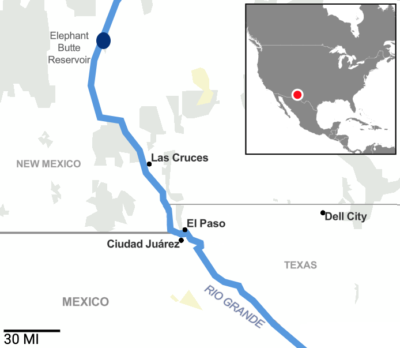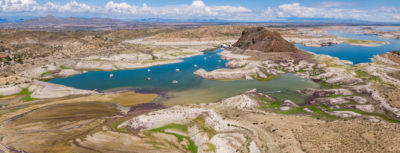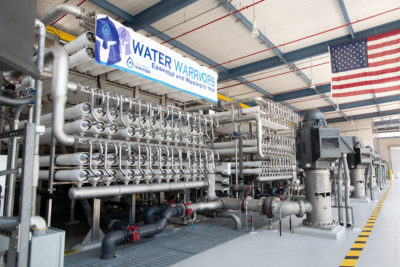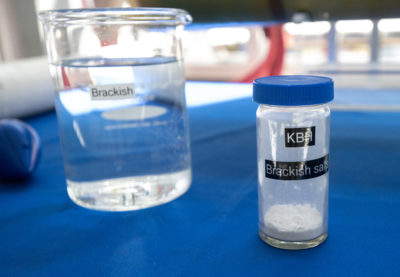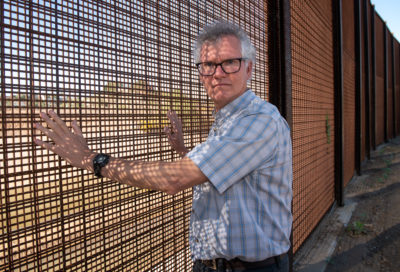
As Rio Grande Shrinks, El Paso Plans for Uncertain Water Future
Since before El Paso was founded by a Spanish missionary in the late 17th century, the Chihuahuan Desert region has been nourished by a steady supply of water: the Rio Bravo Del Norte, as the river is known in Mexico, or the Rio Grande, as it’s known in the United States.
Today, the population on both sides of the international border is booming, fast approaching 3 million. But even as the Paso del Norte region — which encompasses El Paso, Texas; Ciudad Juarez, Mexico; and Las Cruces, New Mexico — prospers, a two-decade-long megadrought exacerbated by a warming climate is bringing more extreme weather and shrinking the lower Rio Grande.
As temperatures have risen and rainfall has decreased, the river’s flow along its entire length will continue to decline, and peak runoff could occur a month earlier. As temperatures continue to rise, scientists predict additional losses may exceed 20 percent by mid-century and 35 percent at the end of the century.
The changes have left urban water authorities scrambling to find ways to provide cities with alternate supplies of water. “We have to prepare for the year that there is no river water,” says Lisa Rosendorf, a spokesperson for El Paso Water, the utility that serves the city, “because that year will come.”
The Rio Grande flows some 1,900 miles from its headwaters in the San Juan Mountains, in southern Colorado, to its mouth near Brownsville, Texas. The nation’s fourth longest river, the Rio Grande has long been known for its low and often intermittent flows; it’s jokingly referred to as the Rio Sand.
But the flow through southern New Mexico and West Texas is exceptionally paltry these days. The Elephant Butte Reservoir — which holds Rio Grande water that is sent downriver to Las Cruces in southern New Mexico and then on to El Paso and Mexico — is currently at 5.6 percent of capacity.
Eighty percent of the river’s flow has historically been diverted to agriculture. But now diminished flows have forced many farmers to either fallow fields or switch from water-hungry crops to those that are more drought tolerant.
Intermittent water shortages have long plagued El Paso, and in the 1950s a withering regional drought spurred the city to begin thinking about sources beyond the river. El Paso Water, the municipal utility, has been ahead of other cities in working to establish these new sources, including desalination, residential and commercial conservation, “toilet-to-tap” wastewater recycling, and importing water from far away. Now, as the city experiences its longest drought on record, these alternatives will be put to the test.
The city of El Paso gets 40 percent of its water supply directly from the Rio Grande. Another roughly 40 percent is pumped from wells drilled into the Hueco Bolson aquifer, which is 200 miles long and 25 miles wide; another 17 percent comes from the smaller Mesilla Bolson aquifer. The city usually pumps from the Rio Grande for 30 continuous weeks of the year. But during this most recent drought, the river has provided water for only six to eight weeks a year.
The Kay Bailey Hutchison desalination plant, completed in 2007, is capable of supplying 5 percent of El Paso’s water. Most people assume that desalination turns only seawater into fresh water, but El Paso’s system — the world’s largest inland municipal desalination plant — generates fresh water from brackish, or mildly salty, groundwater. (Texas aquifers contain approximately 2.7 billion acre-feet of brackish water.) The plant cost roughly $90 million to build, and the city already has plans to expand it.
Elephant Butte Reservoir on the Rio Grande in New Mexico in August 2022. The reservoir is currently less than 6 percent full. Mitch Tobin / The Water Desk
On a tour of the plant, Woody Williams, the plant’s lead technician, points out row upon row of reverse osmosis filters stacked atop each other. Brackish water is piped from deep wells and forced through these membranes, which have pores so tiny that water molecules can pass through, but not molecules of salt and other impurities.
Desalination along coastlines, where most such plants are located, has some major drawbacks. It’s an expensive, energy-intensive process, and plants suck in fish and other marine creatures with the ocean water. Inland desalination, which is also energy intensive, doesn’t kill fish. But like ocean desal, it leaves behind mountains of briny waste. Ocean plants return that salt and other chemical residues to the sea — a potential threat to marine health. El Paso solves its brine problem by piping the waste 22 miles across the arid plains to an injection well where it is stored permanently 4,000 feet underground.
Like other cities in the Southwest, El Paso has long recycled used residential water through its so-called “purple pipe” system, which cleans up wastewater and delivers it for non-potable use on golf courses and park lawns. The city is now upgrading its water recycling plant with a UV disinfection system, reverse osmosis, and microfiltration that will make its end product potable. The “toilet-to-tap” system — the technical term is direct potable reuse — will provide the city with water so clean that minerals will have to be added to improve its taste. The largest such plant in the world, it will cost $150 million to build and is scheduled to open in 2025.
“Everywhere in the Southwest is going to have more expensive water,” says a water expert at the University of Texas.
But El Paso continues to seek new water sources. Since the 1990s, the city has emphasized conservation as a way to stretch its limited water supplies, requiring builders to install low-flow toilets and faucets and limiting the amount of turf in new construction. “The whole culture of landscaping has changed here,” notes El Paso Water’s Rosendorf. Per person usage dropped from 200 gallons a day 30 years ago to about 139 today. The utility has a target of 125 gallons per day by 2030.
To further assure its supply, the city is also buying 70,000 acres of farmland in Dell City, 90 miles to the east. The Texas town has just a few hundred souls but an abundance of groundwater provided by the Bone Spring-Victorio Peak Aquifer. The system is not expected to come online until 2050.
The concept of “buy and dry” — purchasing land only to fallow it, then moving its water elsewhere — has a controversial history in the West. Owens Valley in Southern California is the case study. The valley was home to a prosperous farming community in the early 1900s. But in 1913, agents of the Los Angeles Department of Water and Power, posing as farmers and ranchers, began to surreptitiously buy up land and the water rights that came with it. They diverted that water 233 miles to support the burgeoning metropolis. Springs and seeps soon disappeared, and agricultural land was ruined.
There is nothing surreptitious about El Paso’s approach to the Dell City project. The utility has purchased 20 farm properties for more than $222 million, and until water starts being pumped west, those farmers are leasing back their land at attractive rates.
Left: The El Paso Water Desalination Plant, the largest groundwater desalination plant in the United States. Right: The average amount of salt removed from a beaker of brackish groundwater. Ted Wood
But Dell City makes an expensive source. Pumping and piping water to El Paso will cost the city $3,000 an acre-foot. Treating and distributing an acre-foot of water from the Rio Grande — enough to provide indoor and outdoor water for two urban households for a year — costs $300.
Rate hikes that cover the increased costs will cause financial pain to many. “It’s estimated that households in the lowest income bracket will have to pay 10 percent of their income for water,” says Alex Mayer, director of the Center for Environmental Resource Management at the University of Texas at El Paso. “Everywhere in the Southwest is going to have more expensive water.” Fortunately, utility assistance programs are available to help the very poorest.
“It is an ongoing adaptation [for everyone],” says Sam Fernald at the New Mexico Water Resources Research Institute at New Mexico State University, in Las Cruces. “New Mexico is paying the price for climate change.”
With almost half of its water derived from two aquifers, El Paso worries about overpumping groundwater. The city acknowledges that the way it manages the Hueco Bolson aquifer is not sustainable. It is currently pumping between 60,000 and 70,000 acre-feet of groundwater a year but replacing only about 5,000 acre-feet. Municipal pumping has lowered the aquifer several hundred feet.
Texas has sued New Mexico alleging that its increased groundwater pumping was depriving Texas of Rio Grande flow.
This overdrawing is sometimes referred to as Managed Aquifer Depletion. “Notice the acronym,” says Mayer, with a smile.
Groundwater and rivers are connected, of course, and abstracting too much water from one source can negatively affect the other. In 2013, Texas filed suit against New Mexico, alleging that its increased pumping of groundwater was depriving Texas of Rio Grande flow. The case has continued for nine years, with a hearing in front of a federal judge appointed by the U.S. Supreme Court scheduled for January.
Water authorities are trying to make groundwater use more sustainable, says Scott Reinert, water resources manager for El Paso Water. The utility uses injection wells to return treated wastewater to aquifers, and when it is available, it directs excess Rio Grande water into the city’s Enhanced Arroyo Project — two miles of human-made river channel that allows water to slowly filter into the Hueco Bolson aquifer. Rain is also diverted into basins designed to allow recharge of groundwater reserves.
Mayer says there is a good deal of uncertainty about those reserves. Right now, experts estimate that fresh groundwater will hold out for a few decades, while brackish groundwater will be available for generations.
Alex Mayer, a professor of civil engineering at the University of Texas at El Paso, at the Mexican border. Ted Wood
The end of surface water, however — if it comes to that — signals the end of a living river. Already, the lack of river water in the Rio Grande has robbed people of the opportunity to swim, raft, and gather along its banks, especially in the region’s poorer areas.
To begin to remedy this loss, the Nuestra Tierra Conservation Project, a Las Cruces-based nonprofit that helps communities of color gain access to public lands, has worked with volunteers to create a very modest natural area, called La Mancha Wetland Park, on land donated by a local builder. Here, families can enjoy the outdoors and observe birds and other wildlife drawn to a cattail-rimmed pond dug by machine. “It’s some of the only year-round water in this area,” says Olivia Jensen, Nuestra Tierra’s operations director.
It’s clear, though, that no matter how much infrastructure is built to help offset the great drying of the Rio Grande — whether it’s multimillion-dollar plants or small community-based efforts like this one — the region’s water future remains uncertain.
“The river,” says Mayer, “has proven itself to be unreliable.”
Reporting for this article was supported by a grant from The Water Desk, an initiative based at the University of Colorado Boulder’s Center for Environmental Journalism.
